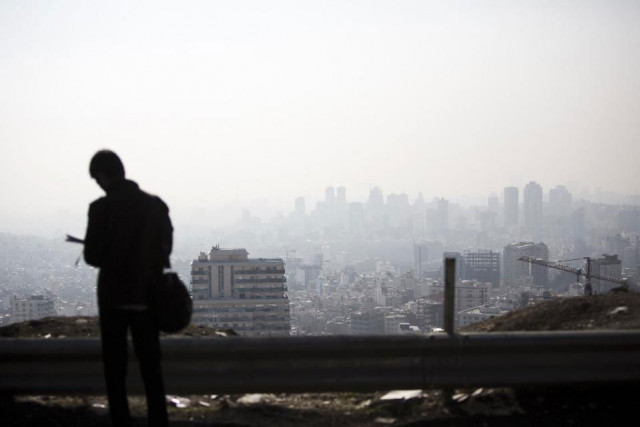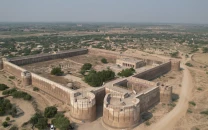Karachi world’s fourth largest polluted city: report
City’s toxic air works as a slow poison, contributing to asthma, nose elegy, sore throat, and heart diseases

Karachi has turned out to be the world's fourth largest polluted city as its air quality index has surged to an unhealthy level of 193, showing utter negligence of the federal and Sindh governments towards environmental reforms, according to a new investigative report released on Sunday.
PM2.5 concentration, as per IQAir organisation report, in Karachi has been recorded 11.8 times higher this month which is above the WHO annual air quality guideline value.
This clearly proves that the federal and Sindh governments’ claims of making huge investments for improving the environment and public health in the city are nothing but disinformation and misinformation, says the investigation report.
The investigation finds that air pollution in Karachi contains solid and liquid particles, and certain gases in the air. The major polluters are transport and industrial emissions followed by burning of garbage, emissions from refrigerators, generators, flying of dust, and stoves used in houses and hotels.
The investigation says that all types of forests, including mangroves along Sindh’s coastline, which used to help absorb carbon dioxide and clean air in Karachi, have been hacked to an alarming level.
Karachi’s present mangroves forest cover is 50,000 hectares. In the last 50 years, Karachi has lost 10,000 hectares of mangrove forest due to encroachments, commercialisation and infrastructure development.
A Sindh Environmental Protection Agency report says that the important ecosystems in Sindh, such as mangroves, have come under extreme pressure due to seawater encroachment and deforestation. There has been mass depletion of mangrove forests in the area due to illegal logging, irrigation and untreated industrial waste.
The report says that only 130,000 hectares of mangroves of the 600,000 hectares that existed at the start of the 20th century are now left. The total land area of Sindh is 34.84 million out of which 8 per cent is forest cover.
According to international standard, a country should have at least 25 per cent of its total land under forest cover to tackle environmental degradation including air pollution.
The new annual economic survey of Pakistan released in June 2021 says that Pakistan is a forest deficient country as it has 5.01 per cent area under its forest cover.
According to WHO, air pollution is one of the biggest environmental threats to human health, alongside climate change. From smog hanging over cities to smoke inside the home, air pollution poses a major threat to health. It causes diseases including heart ailments, strokes, chronic obstructive pulmonary diseases, cancer and pneumonia. Seven million people die globally each year due to exposure to ambient and household air pollution.
Read: Untenable toll of air pollution
Air pollution is a complex mixture of solid particles, liquid droplets, as well as gases. It can come from many sources such as household fuel burning, industrial chimneys, traffic exhausts, power generation, open burning of waste, agricultural practices, desert dust and many other sources.
Air pollutants measured include PM2.5 and PM10 (particles with an aerodynamic diameter of equal or less than 2.5, also called fine, and 10 micrometre respectively), ozone (O3), nitrogen dioxide (NO2), carbon monoxide (CO) and sulfur dioxide (SO2).
Fine particulate matter (PM2.5) can penetrate through the lungs and further enter the body through the bloodstream, affecting all major organs.
Exposure to PM2.5 can cause diseases both to the cardiovascular and respiratory system, provoking stroke, lung cancer and chronic obstructive pulmonary disease.
New research has also shown an association between prenatal exposure to high levels of air pollution and developmental delay at the age of three, as well as psychological and behavioural problems later on, including symptoms of attention deficit, hyperactivity disorder, anxiety and depression.
Read: SEPA seals factory over failure to control pollution
Air pollution is a threat to health in all countries, but it hits people in low-and middle-income countries the hardest,” WHO Director General Tedros Adhanom Ghebreyesus said.
In an interview, National Forum for Environment and Health President Naeem Qureshi said that air pollution was continuously rising in Karachi, mainly due to emissions from transport, followed by industrial emissions and burning of garbage. Transport is creating 70% air pollution in the city.
“The federal and provincial governments have formulated environment policies but they are not being implemented in true spirit, as a result, there is no control on pollution in Karachi,” he said.
Qureshi maintained that certification system of vehicles in the city was bogus which needed to be improved.
There should be effective checking of smoke-emitting vehicles to reduce harmful emissions, he said, adding that mass transit be launched in Karachi at the earliest besides launching electrical vehicles.
Separately, Pakistan Medical Association Secretary General SM Qaisar Sajjad noted that Karachi had turned out to be the world’s fourth largest air polluting city.
“Air pollution is a slow poison and can even take life in severe conditions,” he said, observing that air pollution contributes to asthma, nose elegy, sore throat, and heart diseases.
The PMA president stressed the need to regulate transport and industrial systems, and cease all smoke-emitting and dilapidated vehicles which cause air pollution.



















COMMENTS
Comments are moderated and generally will be posted if they are on-topic and not abusive.
For more information, please see our Comments FAQ